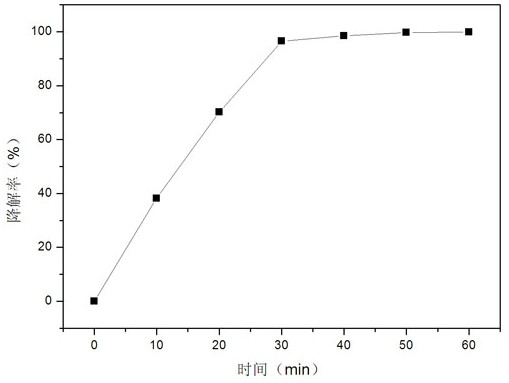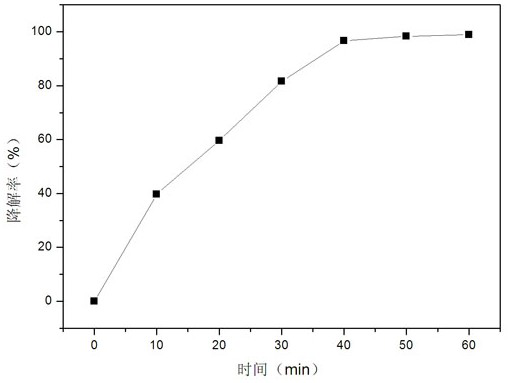Preparation method, product and application of oxygen-deficient titanium disulfide and carbon nano-disc photocatalytic material
A photocatalytic material, titanium disulfide technology, applied in chemical instruments and methods, physical/chemical process catalysts, chemical/physical processes, etc., can solve problems such as ecological and environmental damage, achieve easy operation, improve photocatalytic performance, and prepare The effect of simple process
- Summary
- Abstract
- Description
- Claims
- Application Information
AI Technical Summary
Problems solved by technology
Method used
Image
Examples
Embodiment 1
[0027] An oxygen-deficient titanium disulfide@carbon nanodisc photocatalytic material, prepared according to the following steps:
[0028] Step 1: Add 0.02 mmol tetrabutyl titanate to 10 mL oleylamine, stir it magnetically, and then pass argon gas into it for 30 minutes, gradually heat the solution to 120 °C, and mix the solution thoroughly;
[0029] Step 2: Inject 1 mL of dodecylmercaptan into the above solution, stir magnetically at this temperature for 60 min, then heat to 300 °C, keep the reaction mixture at this temperature for 20 min, and then naturally cool to room temperature ;
[0030] The third step: drop the solution obtained in the second step into liquid pentane, centrifuge the precipitate, and dry the obtained product in a vacuum oven at 60°C to obtain titanium disulfide@C nanodisk;
[0031] Step 4: Put pure titanium disulfide@C nanodisks in a hydrogen atmosphere, and calcinate them at 350 °C for 2 h at a heating and cooling rate of 1 ℃ / min to obtain oxygen-defi...
Embodiment 2
[0034] An oxygen-deficient titanium disulfide@carbon nanodisc photocatalytic material, prepared according to the following steps:
[0035] Step 1: Add 0.04 mmol of tetrabutyl titanate to 15 mL of oleylamine, stir it magnetically, then pass argon into it for 30 min, and gradually heat the solution to 150 °C to make the solution fully mixed;
[0036] Step 2: Inject 2 mL of lauryl mercaptan into the above solution, stir magnetically at this temperature for 30 min, then heat to 280 °C, keep the reaction mixture at this temperature for 30 min, and then naturally cool to room temperature;
[0037] The third step: drop the solution obtained in the second step into liquid tert-butane, centrifuge the precipitate, and dry the obtained product in a vacuum oven at 80°C to obtain titanium disulfide@C nanodisk;
[0038] Step 4: Put pure titanium disulfide@C nanodisks in a hydrogen atmosphere, and calcinate them at 450 °C for 1 h at a heating and cooling rate of 1 °C / min to obtain oxygen-def...
Embodiment 3
[0041] An oxygen-deficient titanium disulfide@carbon nanodisc photocatalytic material, prepared according to the following steps:
[0042] Step 1: Add 0.04 mmol of isopropyl titanate to 15 mL of oleylamine, stir it magnetically, then blow nitrogen into it for 30 min, gradually heat the solution to 150 °C, and mix the solution thoroughly;
[0043] Step 2: Inject 2 mL of 1-docosylmercaptan into the above solution, stir magnetically at this temperature for 30 min, and then heat to 300 °C. The reaction mixture is kept at this temperature for 20 min, and then naturally cooled to room temperature;
[0044] The third step: drop the solution obtained in the second step into liquid tert-butane, centrifuge the precipitate, and dry the obtained product in a vacuum oven at 80°C to obtain titanium disulfide@C nanodisk;
[0045] Step 4: Put pure titanium disulfide@C nanodisks in a hydrogen atmosphere, and calcinate them at 450 °C for 1 h at a heating and cooling rate of 2 ℃ / min to obtain o...
PUM
 Login to View More
Login to View More Abstract
Description
Claims
Application Information
 Login to View More
Login to View More - R&D
- Intellectual Property
- Life Sciences
- Materials
- Tech Scout
- Unparalleled Data Quality
- Higher Quality Content
- 60% Fewer Hallucinations
Browse by: Latest US Patents, China's latest patents, Technical Efficacy Thesaurus, Application Domain, Technology Topic, Popular Technical Reports.
© 2025 PatSnap. All rights reserved.Legal|Privacy policy|Modern Slavery Act Transparency Statement|Sitemap|About US| Contact US: help@patsnap.com



